207 Squadron - Manchesters
The loss of Manchester EM-W L7380 from Bob Kirby
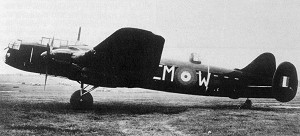 L7380 EM-W is shown at RAF Waddington in an earlier paint scheme. It was delivered on 13th April 1941 and completed five sorties before it failed to return from an attack on Berlin on 7/8 September 1941. 207 Sqn Archives: Raymond Glynne-Owen |
|
|
Realising that damage to the port fuel tanks meant that they would not make it to Berlin and back they instead attacked Wilhelmshaven. Homebound at low level to maximise their remaining fuel, the port engine began to glow red hot and, slowly losing altitude, they had to belly land 100 feet off the water-line of an island off the Dutch coast.
L7380, EM-W of 207 Squadron force landedL7380, EM-W of 207 Squadron was force landed by Flt Lt 'Mike' Lewis in the surf zone on the Dutch barrier island of Ameland following an earlier night-fighter attack on the night of 7/8th September 1941. This incident is described in detail in my book Legend behind the Lancaster from the recollections of Mike Avro Manchester, The and his mid-upper-gunner, Charles Hall. Nothing from the German nightfighter crew in question, not even their identity, has ever been forthcoming. Indeed, the engagement was sufficiently fleeting that the nightfighter crew may have been unaware of the damage they had caused to L7380. The account in the book was enhanced by publication of part of a set of photographs taken by the Germans of the Manchester being investigated and cut up for scrap on the beach at low tide. In the course of research for the book two further survivors from the crew were located. The rear gunner, Erle Miller from Canada, was tracked down but had no interest in reunions or the history. |
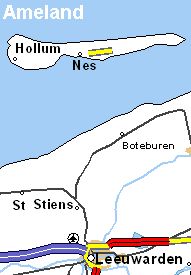 |
|
The second, ex-Sgt Sam Powell, the Second Pilot, was traced to Sheffield and expressed a willingness to contribute his memories of his time in 207 Squadron, including the loss of L7380 but, sadly, died suddenly before matters could be progressed.
The situation remained thus until recently, almost 59 years after the loss when, out of the blue via the 207 website, I received a request from a resident of Ameland, Rene Metz, for a copy of the book. Rene mentioned in passing a set of photographs of the aircraft which he offered to pass on. Anticipating that these would be the same as the set I already had, I responded positively without any expectation of seeing anything new.
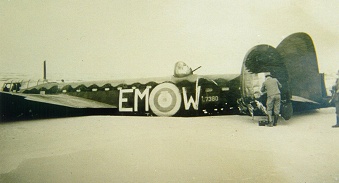
L7380 on the beach being inspected by the Germans
- it soon sank into the sand
Imagine my surprise, then, when a set of 15 photographs arrived, none of which I had ever seen before! 13 showed the aircraft on a number of daylight low tides, initially sitting on the beach, doubtless on the 8th September 1941, and subsequently at various stages of being scoured into the beach. Such self-scouring prevented the Germans from recovering the aircraft intact and instead it was cut up for scrap using oxy-acetylene torches.
The photographic set revealed that the aircraft had been damaged to some degree on hitting the sandy sea bed in the shallow water. An undercarriage leg and mainwheel, both propellers and parts of the undercarriage or perhaps bomb doors had been torn off. More unexpected were photographs of two crew members taken soon after their capture and on the quay at the hamlet of Nes, the ferry terminal for the island. One had a pilot's wings and was obviously not Mike Lewis himself, so had to be Sam Powell, as indeed enquiry proved was the case. The other had a radio operator's badge on the right sleeve and an "AG" badge on the left breast and, amazingly, the face seemed familiar!
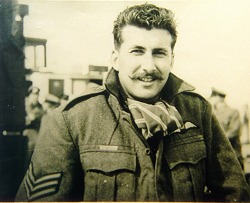
Sam Powell - German officers in the background
By further co-incidence, Charles Hall also lives in Taunton and so I invited him round to inspect some "new information" without divulging more detail. On his arrival I offered the first of the set of photographs asking "Have you ever seen this bloke before?" After a brief pause Charles exclaimed "Well, I'm blowed, it's me!" He had no memory of the photograph ever being taken, which presumably added to the element of surprise. I did reflect, myself, that there must have been something in the thin and miserable 24 year old countenance preserved in the full and cheerful face of Charles today, which enabled me to make the link, despite the passage of close to 60 years!
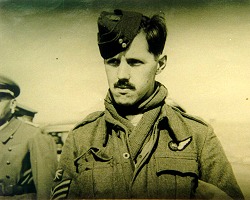
Charles Hall
As with so many similar incidents, a degree of folklore has grown up amongst the isolated Ameland population over the years. According to legend, the first German soldier to encounter the crew mistakenly thought he was being confronted by an invading force, dropped his rifle and raised his hands in surrender before regaining his composure and capturing the crew! For the remaining period of the occupation the locals allegedly gave this particular member of the 'Master Race' the derisory name 'Tommy-catcher'.
Neither Mike nor Charles can recall such an incident, but it no doubt stiffened the spirit of the residents at difficult times. Possibly it relates to a different crew, as more than one Allied aircraft came down on the island during hostilities.
links
www.ameland.net
page last updated 2 Mar 2003 by Frank Haslam, 207 Squadron RAF History